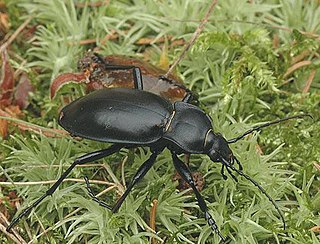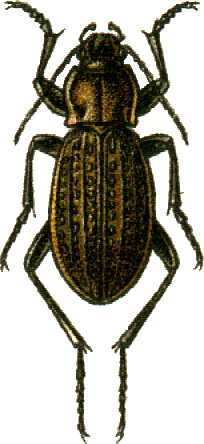
Ground beetles are a large, cosmopolitan family of beetles, the Carabidae, with more than 40,000 species worldwide, around 2,000 of which are found in North America and 2,700 in Europe. As of 2015, it is one of the 10 most species-rich animal families. They belong to the Adephaga. Members of the family are primarily carnivorous, but some members are herbivorous or omnivorous.

Amara is a large genus of carabid beetles, commonly called the sun beetles. Many are holarctic, but a few species are neotropical or occur in eastern Asia.

Calosoma sycophanta, the forest caterpillar hunter, is a species of ground beetle belonging to the family Carabidae.

Carabus is a genus of beetles in the family Carabidae. The genus is highly diverse with 94 subgenera, 959 species and 2300 subspecies, thus is the largest genus in the subfamily Carabinae. The vast majority are native to the Palearctic, but 16 Nearctic species are also known. Carabus spp. are 12–50 mm (0.47–1.97 in) long, and most species are wingless and often very colourful. These are nocturnal, predatory beetles that feed on snails, earthworms, and caterpillars. Most Carabus species were thought to have inhabited the Eurasian forest, but the species' low dispersal abilities altered the distribution of lineages within the genus.

Bembidion is the largest genus of beetles in the family Carabidae by number of species. All species are small and move very fast. Most of them live close to water. The genus has a biantitropical distribution, meaning they are found in both the Northern and Southern Hemispheres, but not in the tropics. In warmer regions it is substituted by closely related Tachys and other genera.

Carabus arcensis is a species of ground beetle in the family Carabidae. It is found in the Palearctic.

Carabus auronitens is a species of beetle in family Carabidae which was described by Johan Christian Fabricius in 1792.

Carabus granulatus is a species of beetle. It is found across the Palearctic from Ireland to the Russian Far East and has been introduced to North America. It is widespread in Europe. C. granulatus lives in fields, prairies, taiga and in forests. Also along river margins, in fens, lakeshores, and upland peat. It is occasional in gardens.

Carabus violaceus, sometimes called the violet ground beetle, or the rain beetle is a nocturnal species of a beetle, from the family Carabidae.

Carabus gigas is a species of beetles of the family Carabidae.

Cychrus is a large genus of rare snail-eating beetles in the family Carabidae. There are at least 160 described species in Cychrus. They are found throughout the world, although more than 80% of the species occur in China.
Pheropsophus aequinoctialis is a species of ground beetle from Yucatán and Central and South America that feeds as larvae on the eggs of mole crickets but as an adult is a generalist feeder.

Carabus solieri is a species of beetles of the family Carabidae.

Lampetis fastuosa is a jewel beetle of the family Buprestidae.
Carabus exiguus is a species of black-coloured ground beetle in the Carabinae subfamily that is endemic to China.
Carabus marietti is a species of ground beetle in the Carabinae subfamily that can be found in Bulgaria, the European part of Turkey, and the Near East.

Carabus vietinghoffii is a species of ground beetle in the family Carabidae. It is found in Europe and Northern Asia and North America.

Carabus maeander is a species of beetle in the family Carabidae. The species fly in May and June, are black in colour and 15 to 23.5 millimetres long. It is found in northeastern United States and both central and southern Canada. The species is also found outside of North America. In Russia, it is found in eastern Siberia while in Japan it is known from Hokkaido and Kunashir Islands. It also exists in South Korea.
Carabus masuzoi is a species of ground beetle, family of Carabidae. It is endemic to Taiwan, and was first found in mid-altitude mountains of central Taiwan. Its body is black colored with longitudinal indents on its elytra, and is capable of flight. Its morphology differs between different habitat types.















